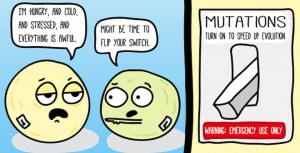
Interestingly enough, this article entitled, Does Evolution Evolve Under Pressure?, in Wired Science magazine discusses a slight departure in the topics discussed Tuesday in class regarding understanding the concept of evolution and natural selection. According to the article, Susan Rosenberg theorized that bacteria can self- mutate in the sense that they can, under pressure, induce increased rates of mutations in the hopes of finding an “escape route”. This sort of theory straddles the lines between Darwinian and Lamarckian realms of thought: the grey area between self-mutation and trial and error. Some may argue that this is a form of artificial selection because the general course of evolution is not occurring – it is being tampered with by the organism itself. This then also begs the question that if this theory holds to be true, then what does this indicate for certain realms of study such as antibiotic resistance and the evolution of cancer? If scientists or researchers could somehow try to control for stressors that induce mutations in the first place, could that somehow impede the process of evolving antibiotic resistance and further change the practice of medicine and oncology? Ideally, if this theory holds to be true and applicable, evolution could not only be important to understand in medical education as an important framework and understanding why, but now could have direct implications to preventative medicine in terms of determining how. Doctors could advise against certain stressors that induce certain mutations in some bacterial infections or certain tumors (that can also develop antibiotic resistance). The article also goes into further detail describing studies that were able to create conditions that induce organisms to mutate at higher frequencies. This theory largely remains controversial, and it would be interesting to look into how critics explain a reasoning behind the successes of these mentioned experiments. A link is provided to the article below: http://www.wired.com/wiredscience/2014/01/evolution-evolves-under-pressure/
It’s interesting to note that the entire theory of this article contradicts what was so drilled into our heads in basic biology-the fact that an organism cannot evolve because it wants to or needs to. However, if we remember another idea that was drilled into our heads, the fact that every all encompassing statement in biology has at least one if not many exceptions, the contradiction becomes easier to accept.
When reading the article assigned for class about LINEs, the idea of an organism “wanting” or “needing” to evolve came up again. Briefly, the article mentions that stress can induce increased occurrences of LINEs transcribing themselves in order to increase the variation in the genome to give more opportunity for natural selection that would hopefully help the organism or species adapt to the stress of the environmental change.
While mutation rates differ between organisms, mutations themselves are random. An organism can’t choose which single nucleotide to change or what changes to make. The idea that an organism could choose a mutation based on some intrinsic need is quite Lamarckian, but this is not what Rosenberg’s results suggest. Instead they demonstrate some plasticity in the rate of mutation. Since mutation rate appears to be a trait that varies, evolution by natural selection follows. I think it’s important to remember that while some mutations could beneficial to the offspring of bacteria with higher mutation rates, most mutations are lethal or deleterious. Almost all of the time the increased mutations will kill the offspring, but since Rosenberg’s experiment is imposing strong artificial selection, the few that have beneficial mutations do “escape.” Mutants are sometimes called “hopeful monsters,” but, truth be told, this personification is a verbal short cut. Monsters they may be, but it’s selection that will decide which prevail, and there is no motivation or direction on the part of the organism. That line of thinking leads down a Lamarckian rabbit hole. Plasticity in phenotype in response to environment is not equivalent to Lamarckian evolution.